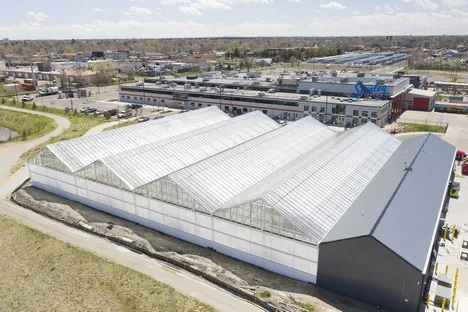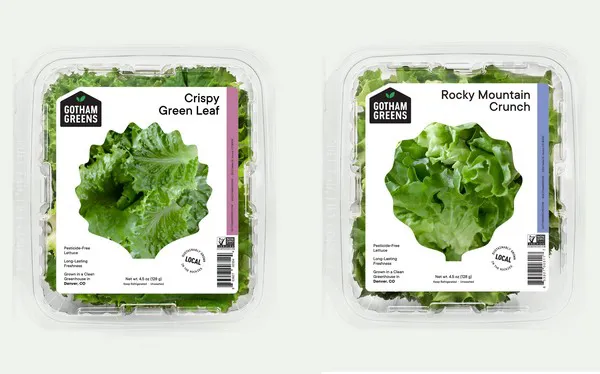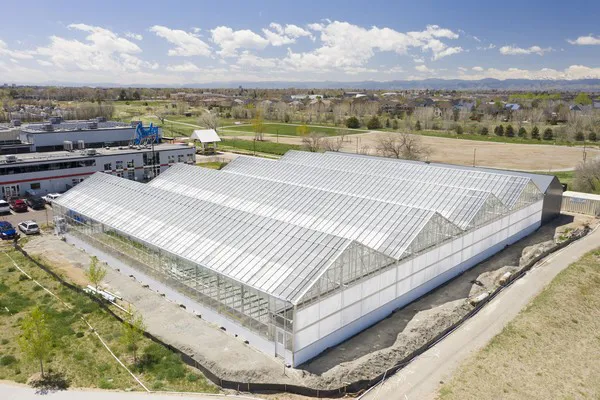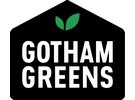In the last six months, US greenhouse company Gotham Greens has more than doubled its footprint by opening four new greenhouses. Newest in their 'collection' is the one in Denver. For decades the area next to an abandoned runway at the former Denver Stapleton Airport site had been sitting vacant. Only 3 years ago it was reopened as an urban marketplace and now the area is revived with the 30,000 square foot greenhouse. "We enjoy pursuing innovative adaptive reuse projects that can transform otherwise underutilized real estate into productive agriculture, whether on rooftops or at grade", says Viraj Puri, co-founder and CEO of Gotham Greens.

Lettuce on NFT
It's a remarkable sight in Denver, Colorado. Next to the 140,000 square foot building in which airplanes were formerly manufactured, a 30,000 square foot greenhouse has appeared. The glass & steel venture is equipped with an NFT-system from which annually 2 million heads of lettuce will be harvested, including two new lettuce varieties: Crispy Green Leaf and Rocky Mountain Crunch. These products will all find their way to grocery retailers across seven states, including Whole Foods Market, Choice Markets, Alfalfa’s and more.

Restaurant and foodservice customers
“We will also partner with restaurant and foodservice customers in the area and supply our products to restaurant and retail customers located at Stanley Marketplace as businesses begin to reopen”, says Viraj, something that has been impossible of course due to the COVID-outbreak. He adds how he never envisioned to open their Denver greenhouse during a global pandemic. “Our entire team worked extremely hard to commission this new greenhouse during the pandemic and we’re proud to be providing people across the country with healthy, fresh food options they can get excited about. Given the current pressures on our country’s food system, one thing is clear: the importance of strengthening our national food supply through decentralized, regional supply chains.”
That has been the vision of Gotham Greens from the start: ever since 2010, when they opened their first greenhouse in Brooklyn, New York, they’ve focused on delivering fresh, locally and sustainably grown produce to customers and our communities. Over the last couple of months they intensified their expansion, resulting in doubling their total growing acreage.
“We built four greenhouses between 2011 and 2015. Rather than focusing on rapid expansion at that point in time, we took a more thoughtful approach to ensure our business model could scale profitably and sustainably in multiple environments and geographies. That patient approach has now positioned and allowed us to scale rapidly sustainably”, says Viraj.
“In the past 6 months, we have more than doubled our footprint by opening four new greenhouses in a strategic and measured way. These include greenhouses in Providence, Rhode Island, Baltimore, Maryland, Chicago, Illinois, and now Denver, Colorado.” In total their annual production now grows to nearly 35 million heads of lettuce and distribution to more than 30 states nationwide.

According to Viraj, the end of the expansion is nowhere in sight. “Looking ahead, our goal is to bring our brand of high-quality, sustainably grown local produce and innovative greenhouses to more cities across the country.” In the past they selected quite some remarkable locations for this: on top of a grocery store, on a manufacturing plant or on the former site of a steel manufacturing plant for example. Viraj explains how a combination of factors drive their decisions for selecting these new locations.
“Customer market size opportunities, zoning, land conditions, and logistics and distribution access, just to name a few. Whether building in a rural area provides a bigger challenge? All greenhouse developments are challenging, and we are becoming more experienced with every subsequent project”, he says.
He adds that their business model has enabled them to remain nimble during these unprecedented times “Now more than ever, we are committed to delivering high-quality, long-lasting and nourishing produce to people when it’s needed most.”

 Gotham Greens
Gotham Greens